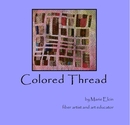When I think about the brain and MRI imaging I always thing of Rorschach blot symmetry. We have bilateral symmetry in our bodies, but not every function in the brain occurs bilaterally. Activity may be localized to one region of the brain in charge of a particular specialty, but even then information passes all over to communicate to the body for movement or the mouth to speak, etc. During our lecture on force networks the idea of paper crumpling came up as something that creates a network of folds and tension points. I wanted to combine these to ideas visually but I didn't want an folds or crumples in my final paper. I started some inkblots on a piece of folded mylar, then transfer printed it to watercolor paper (I might want to try a different, smoother paper as I didn't like the resulting texture in this one) I made bunch of those, adding some watercolor by reprinting over the india ink. I did try crumpling one of my watercolors, but guess what? Thick watercolor paper doesn't like to crumple!! I folded a piece of newsprint in half so my crumple would have bilateral symmetry, then overlaid it on my inkblot and used a seam ripper to poke holes through the papers to transfer the crumple nodes to my painting. Finally I stitched black thread to create edges between the poked nodes. I'm going to take all my experiments with me on Monday to share with the group. Depending on feedback I may continue doing these or maybe continue my polka dot nodes instead.
However, there is still something dissatisfying with these. I'm really only exploring the basics of what a network looks like in these pieces. There is no corresponding data resource that I am trying to visualize. I feel they would be more meaningful if they were connected to a data set in the real world.... But what should that be and how will I find it?
Saturday, July 9
Thursday, July 7
Skirkanich 4
Something about all our talk of networks and topology and brains made me think about hyperbolic structures and crochet. Crocheting mirrors some network structures. I think of a crochet stitch like a little pi symbol, with a loop at the top (a node) and two legs (edges). A hyperbolic surface curves to maximize surface area. In physical space it takes up 3 dimensions, but topologically it is flat. If you have an endlessly branching network (each node subsequently branches off to two new nodes ad infinitum) eventually you run out of physical space to place the next generation of nodes as they branch outward and the surface begins to curve. The brain appears to have folds and ripples like this- it's one way to pack a lot of surface area into a small space. I made this small hyperball in a rainbow variegated yarn, which when complete reminded of the fMRI colorations showing activity and connection. I might make another in white and then stain specific areas.
Just as I felt a need to explore the topology idea in my previous post, I also want to explore different network structures. I played with "inking" this polka dot stamp I had with gradations of watercolor. It's beautiful, subtle color. The polka dot stamp creates a consistent and reproducible field of nodes upon which to play. I first did a little pencil and watercolor work (below) inspired by some discussion of the "Plinko" game.
Then tried a branching network, stitching the edges and then painting in the resulting negative space- the holes. I didn't quite understand the lecture we had that discussed brain topology and "holes". Have to think about ti some more. I'm still playing.
Labels:
painting,
printmaking,
skirkanich,
stitch,
visual thinking
Wednesday, July 6
Skirkanich 3
I'm sure we were given an intro to topology during our lecture week because it helps consider networks as something to be analyzed independent of physical space. To think about connections and networks in the brain, you might need to pull them out of their tightly clustered physical confines and examine them simply in terms of numbers. But the concepts of topology itself blew my mind! I'm accustomed to the middle school level of geometry and understanding the structures of cubes etc in physical space. Imagine being able to stretch apart the vertices however far necessary to just look at the structure of vertices connected by edges. The visual possibilities sparked my curiosity.
On the way home on the last day of our lectures I happened upon the overflowing dumpster outside of the School of Design. Among the discarded sculptures I found a little model of a tetradecahedron made of thin cardboard. It seemed such a perfect little model of the math ideas we'd heard about over the week. I was reminded of Joseph Kosuth's One and Three Chairs piece, and so I painted the cardboard form in a complementary gradation, painted a geometric version of it unfolded, painted a topological version of it stretched out, and painted its definition. They are all visualizations of the same object. They all represent a tetradecahedron (or cuboctahedron). Which version would allow someone to understand the object best? Do you need to know what something is in physical space? Would a definition provide enough information? If you saw it topologically would you make the jump to geometry easily?
I think where I am going with this is that this is why we are involved in this internship at Penn. There is more than one way to understand information- and maybe you can't fully comprehend a science until you look at the information backwards, forwards, flattened, stretched, and insideout.
Subscribe to:
Comments (Atom)










